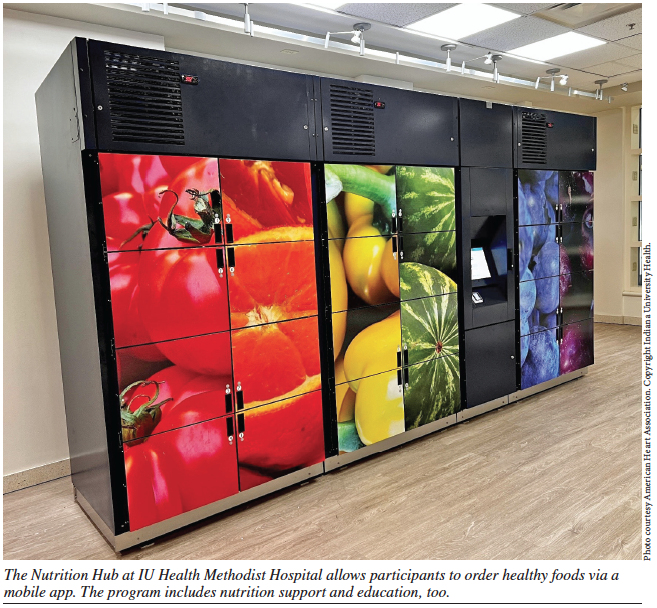
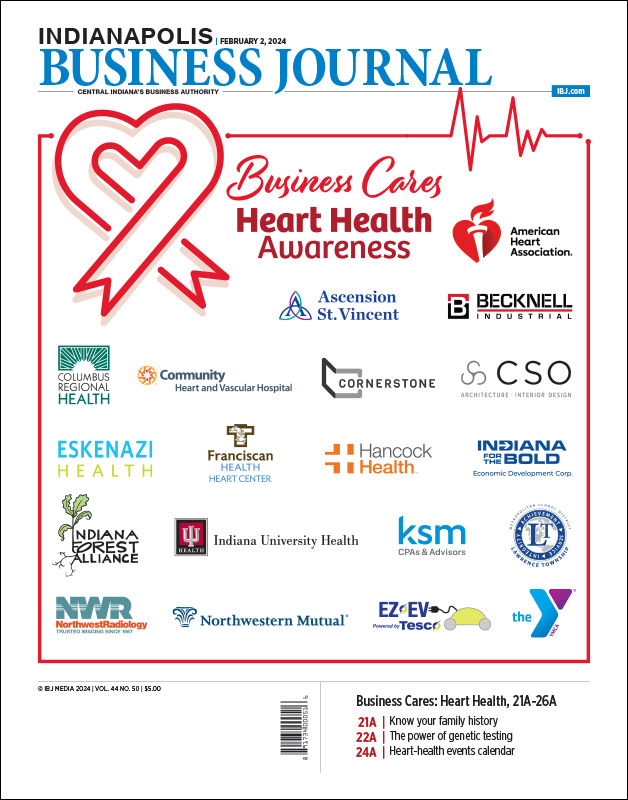
Welcome to IBJ’s “Business Cares: Heart Health Awareness” Microsite
This year’s site is full of good ideas about taking care of your heart and the important role family history and genetic testing are playing in the prevention and treatment of cardiovascular disease—the No. 1 killer in the United States.
View calendar now View the interactive edition
- Ramsey Grice was on a training run with his niece when he started experiencing heart attack symptoms. He says he recognized what was happening only because he knew his family’s heart history.
- A Franciscan Health cardiologist explains the growing role of genetic testing in the prevention and treatment of heart disease.
- A cardiologist at IU Health explains the importance of identifying and treating inherited forms of high cholesterol.
- The American Heart Association and partners launched the “Nutrition Hub,” a new way to distribute nutritious, heart healthy foods to the people who need it most.
- The co-chairs of this year’s Go Red for Women campaign are eager to spread the message about hands-only CPR.
Thank you to the 19 companies and organizations listed below that sponsored this important section of IBJ. Their investment will fund a heart health awareness campaign throughout the month of February via print, digital and e-newsletter platforms.
And thank you to our readers. We hope you’ll support our sponsors as they join all of us in working to make Hoosiers healthier by improving awareness and treatment of cardiovascular disease.

Nate Feltman
Publisher, President & CEO
- American Heart Association
- Ascension
- Becknell Industrial
- Columbus Regional Hospital
- Community Health Network
- Cornerstone Companies, Inc.
- CSO
- Eskenazi Health
- Franciscan
- Hancock Health
- IEDC
- Indiana Forest Alliance
- IU Health
- Katz, Sapper & Miller
- Metropolitain School District – Lawrence Township
- Northwest Radiology
- Northwestern Mutual
- Tesco
- YMCA
Please look for the next installments of IBJ’s Business Cares Series: Diversity, Equity, & Inclusion on July 5, Breast Cancer Awareness on October 4 and Corporate Social Responsibility on November 15.
On National Wear Red Day, thousands of people, including employees at more than 10,000 companies across the country, will wear red to support the start of American Heart Month. This year is the 23rd annual National Wear Red Day. Post a picture of yourself wearing red using the hashtag #IndyGoesRed and tag @AHAIndiana on Facebook, Twitter or Instagram.
12-12:30 p.m. / WRTV-6
The American Heart Association celebrates its 100th year with a five-part TV series highlighting its work in Central Indiana. This episode focuses on high blood pressure—the silent killer—and how the AHA is working with organizations to help people control it.
Congenital heart defects affect nine of every 1,000 births and are one of the leading causes of death for infants less than 1 year of age. Thanks to years of research and medical advancements many congenital heart defects can be fixed.
8:30 a.m. – 12:30 p.m., Knights of Columbus,2100 E. 71st St. Mended Hearts Chapter 350, a local heart support group, will host a fundraiser to raise money for the promotion and gifting of heart scans. Contact mncnorman@gmail.com for information.
12-12:30 p.m. / WRTV-6
The American Heart Association celebrates its 100th year with a five-part TV series highlighting its work in Central Indiana. This episode focuses on the lifesaving skill of Hands-Only CPR.
9 a.m. – Noon / Marion County Clerk, W-122 City County Building, 200 E. Washington St.
The Marion County Clerk’s office will conduct wedding ceremonies to raise money for the American Heart Association. Couples who desire a simple civil ceremony or vow renewal can make a $50 contribution to the American Heart Association in lieu of an officiant’s fee. Couples can make a reservation by calling (317) 327-5099.
2-9 p.m. / Indiana Convention Center, 100 S. Capitol Ave. Tickets required
The American Heart Association will offer free training in the lifesaving skill of Hands- Only CPR as part of the NBA Crossover event during NBA All-Star Weekend
11 a.m. – 6 p.m. / Indiana Convention Center, 100 S. Capitol Ave. Tickets required
The American Heart Association will offer free training in the lifesaving skill of Hands-Only CPR as part of the NBA Crossover event during NBA All-Star Weekend
12-12:30 p.m. / WRTV-6
The American Heart Association celebrates its 100th year with a five-part TV series highlighting its work in Central Indiana. This episode focuses on programs to improve access to healthy foods, giving people an opportunity at a healthier life
More than 20 local companies will host healthy food drives to support local food pantries, including the IU Health Nutrition Hub at Methodist Hospital. To support the food drive by donating food at one of the participating companies, contact Elijah. sutton@heart.org.
12-12:30 p.m. / WRTV-6
The American Heart Association celebrates its 100th year with a five-part TV series highlighting its work in Central Indiana. This episode focuses on reducing the burden of tobacco and vaping on Hoosiers, especially youth.
10 a.m. – 1 p.m. / Marriott Downtown, 350 W. Maryland St., Indianapolis
The 20th annual Go Red for Women Experience is the cornerstone event of the Go Red for Women campaign, celebrating achievements in helping women live longer, healthier lives. This year attendees will learn the lifesaving skill of Hands-Only CPR while hearing from heart disease survivors and local leaders. For more information, visit www.heart.org/indygoesred.
Family bond, history push Howard County man to seek care after heart attack
By George Mast
Ramsey Grice and his niece Kendall High are a familiar sight around western Howard County as the duo log training miles around the back roads and streets in and around the small town of Russiaville.
Grice has been pushing the 19–year–old in her adaptive racing chair for eight years. The competitive races and hundreds of miles spent training provide a freedom for High, who has Cerebral Palsy and a seizure disorder, and an outlet from a difficult past for Grice.
These days—15 months removed from a near fatal heart attack—Grice has a reoccurring thought on his mind as he pushes for new personal best times on his runs and as he dreams of ways he can use his story of overcoming personal and health concerns to inspire others.
“I’m [living] on time that I didn’t have on Saturday, Oct. 1, and I’m very, very aware of that,” the 51-year-olds aid recently, reflecting on the fall afternoon in 2022 when he had a massive heart attack.
For Grice, that Saturday in 2022 was like many others as he set out on a familiar 13-mile route with High. But midway through the run he began experiencing discomfort in his chest and trouble keeping pace.
Grice’s father was 39 when he had his first heart attack. His two brothers were also in their 30s when they both had heart attacks. Grice’s heart attack came that Saturday afternoon at age 50.
As a self-employed floor installer, Grice did not have health insurance and he had avoided going to doctors for most of his adult life. While he cut his run short that afternoon, he initially tried to wait out his symptoms. As his breathing steadily became even more difficult Grice grappled with his longtime desire to avoid seeking care vs. the reality that his body was running out of time.
“I knew every breath I was taking was possibly my last one,” Grice said.
Ultimately, his bond with his niece and his desire to continue their shared love for running spurred him to action. Enroute to Community Howard Regional Health in Kokomo, a medic in the ambulance confirmed Grice was indeed having a heart attack and notified the team at the hospital to get ready.

Grice was taken to a heart catheterization lab at Community Howard, where interventional cardiologist Dr. Rajesh Mallela placed a stent in his artery to restore the blood flow.
“That quick, the shaking stopped,” Grice recalled. “I could breathe, and I wasn’t dying anymore.”
Two days later Grice returned home. Soon after, he returned to work. He also began to let his mind wander about what he could do next.
“I don’t have a 99 percent blockage anymore, so I wonder how good I can be now?” he thought.
Grice is continuing to answer that question. On the one-year anniversary of his heart attack, Grice and High raced again, setting a new personal best time. On Dec. 2, 2023, he improved that time yet again.
“It’s always rewarding to see a patient not only recover, but to go on to really thrive,” said Mallela. “It is also a Family bond, history push Howard County man to seek care after heart attack Photo courtesy Community Health testament to why we are proud to offer this level of care.”
While Grice’s active lifestyle checks many of the boxes for good heart health, hereditary heart disease poses significant risk even to those who live otherwise healthy lives.
“We understand a lot of the risk factors for having a heart attack, and family history is a primary indicator,” said Mallela. “If there is a history of heart disease in your family, it is really important to talk to a doctor about that.”
Mallela said the risk factors for heart disease for men and women include high blood pressure; high cholesterol; diabetes; a family history of cardiovascular disease; obesity; smoking; and significant stress. Women who are post menopausal are also at greater risk.
Mallela encourages those with risk factors to talk to their doctor about preventative heart and vascular screenings. Community Health Network also offers a convenient, free way to take an online health risk assessment at eCommunity.com/HRA.
As Grice continues to look to the future, his drive to run faster and to inspire and challenge others through his personal story come in part from a desire to honor Mallela and the medical team that saved his life.
“I know I owe him more than money,” Grice said of Mallela. “I am very, very aware of that. He is now on the list of people who I owe to be as good as I can be.”
Mast is director of business development at Community Howard Regional Health.
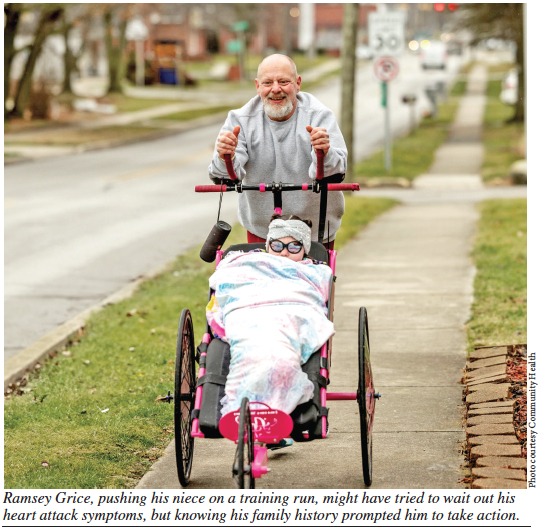
Genetic testing can optimize treatment for cardiovascular conditions
Advancements in genetic testing have proven beneficial for many areas of health. Armed with one’s family history, alongside the expertise of genetic counselors, cardiac specialists are helping to proactively identify and address heart issues.
However, George Lolay, MD, FACC, cardiologist with Franciscan Health Indianapolis, says patients also need to be active participants in taking preventative measures.
“What we need our patients to do, over time and working with their physicians, is to enhance their literacy when it comes to cardiovascular genetics,” Dr. Lolay said. “We can do that by having the mask their parents and siblings about early-onset heart attacks, high cholesterol that runs in the family, the presence of sudden cardiac death in the family, or just having an unknown cause of death in otherwise healthy individuals. “The ideal scenario is to capture family history across a minimum of three generations, in order to have a better understanding of the disease or genetic predisposition.
4 Categories of Hereditary Influence in Heart Disease
Some diseases have greater hereditary influence than others. Dr. Lolay describes genetic heart disease in four broad categories:
- Channelopathies, or abnormal channels or “gatekeepers” within the heart cells. This can lead to heart rhythm disturbances.
- Cardiomyopathies, which involve heart failure due to a weak heart.
- Aortopathies, where patients tend to have a progressively enlarging aorta over time. At some point, the heart can suddenly rupture, causing cardiac death.
- Familial hypercholesterolemia, which is a strong family history of high cholesterol. “In those families, you would have high cholesterol with early onset. So, when you’re 24, 30 years old, you might have significantly high cholesterol, which obviously leads to early-onset heart attacks,” Dr. Lolay said. (Learn more about familial hypercholesterolemia on page 27.)
Using Genetics to Tailor Heart Treatment
Genetics in cardiovascular disease uses an approach that mirrors other disease states, such as breast cancer.
“With breast cancer, there are certain genes that help determine the preferred chemotherapy regimen. Some patients might respond [better] to a certain chemotherapy based on the genetic sequence compared to other patients,” explained Dr. Lolay. “So, we take this same idea, where we try to individualize medical therapy and apply it to heart disease.”
For example, if patients have a family history of high cholesterol, the goal is to treat them aggressively and as soon as possible in order to reduce the risk of major health events, including heart attacks, strokes and heart failure.
Another example is in patients who have abnormal channelopathies or sudden cardiac death from causes other than heart attacks. These heart patients may benefit from a defibrillator, which is a small device placed underneath the chest.
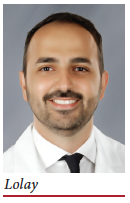
“In the case they develop an abnormal rhythm, it would shock them out of the abnormal rhythm,” Dr. Lolay said. “Overall, the genetic component of heart disease helps us tailor the intervention or the medical therapy to the individual.”
Genetic Counseling is a Team Effort
In genetic counseling, physicians are only part of the equation. Board-certified genetic counselors play a major role as well. If a strong genetic component is identified based on one’s family history, Dr. Lolay schedules patients to meet with one of the genetic counselors. The counselors first educate the patient about the strengths and limitations of a particular genetic test. Once consent is given by the patient, a blood sample is tested for certain genes.
When the test results return to the ordering practitioner, multiple steps take place at once. The genetic counselor indicates whether a genetic variant has been identified (or not).
“If a variant exists, the patient is informed and the genetic counselor refers the patient back to, in our case, a cardiologist,” Dr. Lolay said. “At that point, we sit down with the patient to try to identify what we need to do next, whether it’s medical intervention or further testing.”
Understanding Genetics is Part of the Solution
For genetic considerations to have a true impact on one’s cardiovascular health, Dr. Lolay says it’s critical for individuals to have a solid understanding of their family history.
“It’s really not a whole lot of work. We just need you to sit down with your immediate relatives—your siblings, parents, grandparents—and ask, ‘Did anyone in the family have early-onset heart disease or cancer, diabetes, thyroid problems?’ Because it’s not just the heart where we care about family history, it is other diseases as well. The more data we have, the more educated decisions we can make.”
Content provided by Franciscan Health. Learn how to get a free heart health risk assessment at FranciscanHealth.org/HeartCare.
When a family history of heart disease is something more serious
By Dr. Julie Clary
Many people know that heart disease runs in their family, but for some people, that family history is an inherited genetic condition affecting their cholesterol. These genetic forms of high cholesterol carry an even higher risk for cardiovascular disease than high cholesterol alone, which can have many different causes. Early diagnosis of this “family history” is critical because early treatment significantly reduces risk of cardiovascular disease.
Familial Hypercholesterolemia, FH, is a common, under diagnosed, inherited condition affecting approximately 1 in 250 individuals. People with FH have very high levels of bad cholesterol, LDL-C, in their blood, even if they follow strict lifestyle guidelines. This is due to a malfunctioning copy of a gene that controls how their body handles cholesterol.
Untreated men with FH have a 50 percent chance of having a heart attack by the age of 50, and untreated women have a 30 percent chance of having a heart attack by the age of 60. Unfortunately, only about 30 percent of people with FH have been appropriately diagnosed.
Most individuals with FH have only one abnormal copy of a cholesterol gene; this is called heterozygous FH. However, some people will inherit an abnormal gene from both parents, meaning they have two abnormal cholesterol genes. These individuals have homozygous FH and LDL-cholesterol values that are between 4 and 10 times normal. People with homozygous FH havea serious, life-threatening condition and can start having cardiovascular disease in their teenage years. Thankfully, this is much less common, only affecting 1 in 300,000 people around the world.
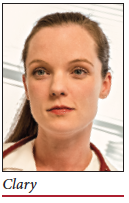
Once diagnosed, there are many affordable, effective, and well-tolerated treatments for FH. Most patients can be managed with oral medications, although many require injectable medications to control their cholesterol. Some patients, however, especially those with two abnormal copies of the genes, will need more advanced therapies. All patients with FH benefit from evaluation and treatment by specialists to reduce their risk.
FH is suspected using clinical criteria and confirmed with genetic testing. Clinical diagnosis is made based on cholesterol levels, personal and family history of premature cardiovascular disease, and physical exams that reveal cholesterol deposits far from the heart. A white ring of cholesterol around the colored position of the eye is called an arcus and is abnormal in people less than 45 years of age. A thickened or lumpy Achilles tendon may represent axanthoma and can be seen in FH as well. Lastly, although many individuals with FH have whitish-yellow plaques around the eyes, called xanthelasma, these can be seen with any form of high cholesterol and do not mean a person has FH. However, people with FH often do not express these physical abnormalities, so not having them does not rule out FH.
If you have the most common form of FH, your children have a 50 percent chance of having FH as well, regardless of their gender. Because of this, once an individual is diagnosed, cascade screening of all close family members is recommended. This means family members should have their cholesterol checked, and if a genetic diagnosis is confirmed, family cholesterol screening paired with targeted genetic testing is the preferred comprehensive strategy to confirm or rule out FH in each family member. Treatment can start as early as 8 years of age and can reduce the risk of cardiovascular disease to that of the general population, which makes screening critical in saving lives.
Another inherited condition is elevated lipoprotein(a), or Lp(a), pronounced “L-P little-A.” Lp(a) also carries cholesterol in the blood, and elevated levels cause premature disease. One in five individuals have elevated Lp(a) and most of these people are undiagnosed. Unlike regular LDL cholesterol, Lp(a) doesn’t respond to lifestyle modifications, and there are limited medications to treat it. Many drugs are currently in clinical trials and hopefully will provide additional therapies in the coming years. In the meantime, it is important to reduce your risk in all other areas—control regular LDL cholesterol (often with statin medications), control blood pressure, exercise, and don’t smoke!
Inherited conditions causing high cholesterol and early onset heart and vascular disease are very common and often undiagnosed. Undiagnosed FH and elevated Lp(a) truly are “silent killers. ”Early diagnosis and treatment save lives, so make sure you and those you love have their cholesterol and Lp(a) checked—and if the values are abnormal, seek expert medical care.
Clary is a cardiologist at IU Health.
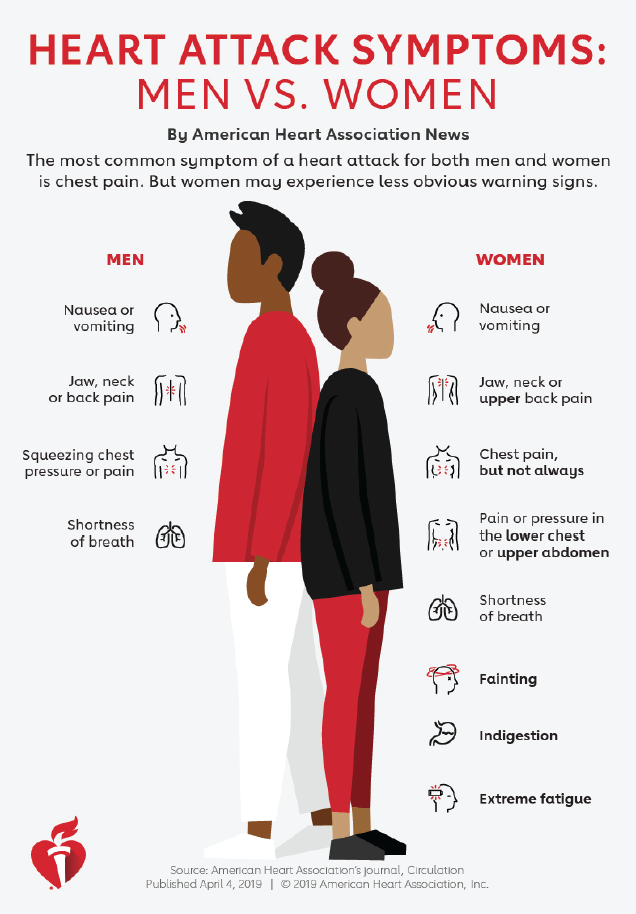
Cooke, Lucas lead 20th anniversary heart health campaign
We all have the power to be life savers. That’s more than a statement, it’s a call to action from Elizabeth Cooke and Katie Lucas to women throughout central Indiana to take charge of their heart health. The two dynamic women have stepped forward to lead the American Heart Association’s 20th anniversary Go Red for Women campaign, which is part of the organization’s centennial.
For Cooke, an ‘aha!’ moment came in January 2023 when football player Damar Hamlin suffered a cardiac arrest during a nationally televised NFL game.
“The media kept saying, ‘this is the best place he could have had this episode because all these elite NFL trainers are so knowledgeable with CPR’,” recalls Cooke, a longtime community advocate in Indianapolis. “And I thought to myself, ‘Why? Why can’t we all be good at this? Why can’t we all be able to save a student athlete on a high school playing field or a friend or a family member or a stranger who has a cardiac episode?’
“And then I learned that people are less likely to perform CPR on a woman (than a man), and so the more I learned, the more I knew this is something I had to help with.”

Hands-Only CPR is a major focus of the Go Red for Women campaign this year with the Association hoping to train at least one person in every household in the life saving skill as part of its “Nation of Lifesavers” campaign. Approximately 70% of cardiac arrests occur in the home, meaning it’s often a loved one in need of help.
For Lucas, being a lifesaver means encouraging women to be aware of their health, taking action when something doesn’t seem right and educating others about heart disease and stroke.
“Two years ago, I was diagnosed with a heart condition,” says Lucas, who is chief administrative officer at Lucas Oil Products. “I was extremely fortunate that I knew how serious my symptoms were and that I understood the urgency of getting to a doctor.
“Women tend to take care of everyone else first and ignore what may be happening in their own body. I hope to inspire and empower women to make their health a priority, to take control of their well-being and to take action to lower their risk of heart disease and stroke.”
Lowering risk can best be achieved by paying attention to eight factors for ideal heart health, what the American Heart Association deems “Life’s Essential Eight.”
Those are:
- Eat better
- Move more
- Get healthy sleep
- Quit tobacco
- Manage weight
- Control cholesterol
- Manage blood pressure
- Manage blood sugar
Lucas also advises women to know the signs of a heart attack and a stroke.
“Awareness is imperative. Heart disease and stroke run in my family and knowing the signs and symptoms have saved my family members’ lives,” she says. “It is also critically important that Elizabeth and I educate women on our greatest health threat—heart disease. Knowledge is power.”
Awareness is a key component of Go Red for Women as less than 50% of women are aware that cardiovascular disease is their leading cause of death.
“Katie and I are honored to work together and with a team of great community leaders to help women live longer, healthier lives,” Cooke says. “There are so many facets to Go Red for Women and so many ways to get involved. I hope others will join us on this mission.”
The celebration of the year-long Go Red for Women campaign will be the annual luncheon on Friday, March 1. For information about getting involved with Go Red for Women, visit www.heart.org/indygoesred.
Content provided by the Indiana Chapter of the American Heart Association.

Nutrition Hub addresses food insecurity, fights heart disease
You are what you eat. It’s a familiar saying to all of us, reminding us that the healthier we eat the healthier our bodies will be.
In the medical world, that saying is taking on new relevance with the growing concept of “food as medicine” —the idea that prescribing and providing fresh produce and healthy foods to people with health issues will make a dramatic impact on their health.
An innovative food-as medicine program kicked off in Downtown Indianapolis late last year. Last November, the American Heart Association, Gleaners Food Bank of Indiana, Indiana University Health and Purdue University Center for Health Equity & Innovation cut the ribbon on a “Nutrition Hub” at IU Health Methodist Hospital.
“This is a tremendous opportunity to improve the health of people with the greatest cardiovascular health risks by providing healthy food and education,” said Dr. William Gill, a cardiologist with IU Health who also serves as president of the American Heart Association’s local board of directors. “Nutrition insecurity is one of the main drivers of disparate health outcomes observed for underserved communities in Indianapolis.”
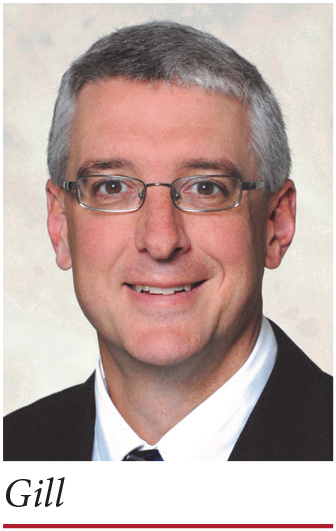
The program began by enrolling eligible IU Health patients and will expand this year to additional downtown neighborhoods in the 46202 ZIP code. Participants are able to pre-order healthy, culturally relevant foods via a new mobile app developed by Gleaners and pick up that food from refrigerated lockers at IU Health Methodist Hospital that are accessible 24 hours a day (the IU Health Nutrition Hub). Participants also receive nutrition support and education from community health workers as part of their ongoing care.
“Our goal is to eliminate as many barriers as possible from people being able to access fresh, nutritious food, ”said Mary Dubinin, director of community collaborations with Gleaners. “This program enables us to more efficiently provide food to those who need it while enhancing not only the user experience from a convenience standpoint but also adding in health information regarding the food choices.”
The program connects participants with a community health worker to customize an initial 7-day supply of perishable and nonperishable foods. Participants then use the online ordering system to order 50-75 pounds of nutritious foods for their household every week.
“After implementing similar programs in several other countries around the world, such as Kenya, it is exciting to see the growth in interest in addressing the underlying social determinants of health like nutrition insecurity in America,” said Dr. Sonak Pastakia, professor with the Purdue University Center for Health Equity and Innovation.
“At the height of the HIV pandemic in Africa, we saw dramatic improvements in outcomes resource-constrained patients experienced when we combined medications with fresh produce prescriptions. We are now seeing the same things in America as we launch programs to address the rapidly growing burden of chronic diseases like diabetes. It is exciting to start seeing patients in Indiana experience similar benefits to what we have seen elsewhere.”
According to Gleaners, more than 17% of people in Marion County are at or below the poverty rate, and more than 128,000 people are food insecure.
“We see increasing prevalence of food insecurity and malnutrition contributing to adverse health outcomes and chronic health conditions in our patients and community members,” said Kristen Kelley, executive director for quality and safety at IU Health Methodist and University hospitals. “While this work directly aligns with IU Health’s vision to make Indiana one of the healthiest states in the nation, we know it will take everyone in our community to solve this growing health issue.”
This program represents an important step in integrating social determinants of health into the health system and developing a broader food as-medicine program that will help Hoosiers live longer, healthier lives with fewer chronic diseases while also reducing health care costs. Several local companies are conducting healthy food drives the week of Feb. 19 to support the Nutrition Hub. For information on donating healthy food, please contact jmeka.christian@heart.org.
Content provided by the Indiana chapter of the American Heart Association
